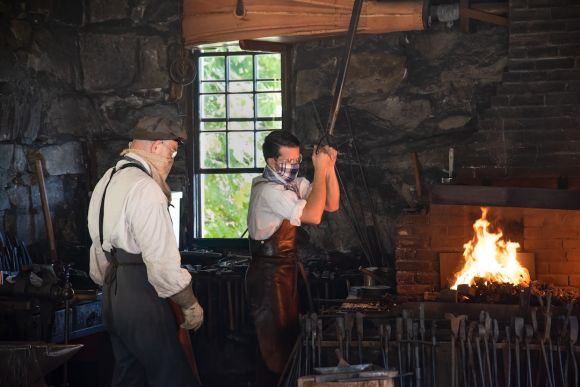Blacksmithing is an ancient craft that has been practiced for thousands of years. It is a skill that requires not only strength and precision, but also a deep understanding of the materials and tools involved. One of the key elements of blacksmithing is the heating of metal, which allows it to be shaped and manipulated into various forms. In this article, we will explore the different heating techniques used by blacksmiths throughout history, and how they have evolved over time.
The Forge: A Crucial Tool in Blacksmithing
At the heart of every blacksmith’s workshop is the forge. This is where the magic happens – where raw metal is transformed into intricate works of art. The forge consists of a firepot, a hearth, and a chimney. The firepot is where the fuel is burned, producing intense heat. The hearth holds the firepot and provides a stable base for the forge. The chimney allows for proper ventilation, preventing the buildup of smoke and fumes.
Coal: The Traditional Fuel of Blacksmiths
For centuries, coal has been the fuel of choice for blacksmiths. It burns at a high temperature, allowing for efficient heating of the metal. The process begins by placing the coal in the firepot and igniting it. As the coal burns, it produces a bed of hot coals that can reach temperatures of up to 2,800 degrees Fahrenheit. The blacksmith then uses a bellows or a blower to supply air to the fire, increasing the heat and intensity of the flames.
The Science of Heat: Understanding the Color Spectrum
Blacksmiths rely on their senses to determine the temperature of the metal they are working with. By observing the color of the metal, they can gauge its heat level. As the metal is heated, it goes through a range of colors, each indicating a different temperature. For example, a bright red color signifies a temperature of around 1,800 degrees Fahrenheit, while a pale yellow color indicates a temperature of around 2,200 degrees Fahrenheit. By carefully monitoring the color of the metal, blacksmiths can ensure that it is heated to the correct temperature for shaping and forging.
Alternative Heating Techniques: From Gas to Electricity
While coal has been the traditional fuel for blacksmithing, modern blacksmiths have embraced alternative heating techniques. One such technique is the use of gas forges, which offer greater control over the temperature and allow for more precise heating. Gas forges use propane or natural gas as fuel, and can reach temperatures of up to 3,000 degrees Fahrenheit. Another alternative is the use of electric forges, which are powered by electricity. Electric forges are convenient and easy to use, but they may not reach the same high temperatures as coal or gas forges.
The Evolution of Blacksmithing: From Ancient Times to the Present
Throughout history, blacksmithing has evolved alongside advancements in technology and metallurgy. Ancient blacksmiths relied on simple tools and heating techniques, such as charcoal fires and hand-operated bellows. As time went on, improvements were made, such as the invention of the water-powered trip hammer in the Middle Ages. This allowed for more efficient forging of metal, leading to more intricate and complex designs. In the modern era, blacksmithing has become a specialized art form, with blacksmiths using a combination of traditional and modern techniques to create unique and innovative works of metal art.
In conclusion, the art of blacksmithing is a testament to human ingenuity and craftsmanship. The heating techniques used by blacksmiths throughout history have played a crucial role in shaping and forging metal. From the traditional use of coal to the modern advancements in gas and electric forges, blacksmiths have adapted their techniques to suit the changing times. Whether using ancient methods or embracing new technologies, blacksmiths continue to create stunning works of art that showcase the beauty and versatility of metal.





